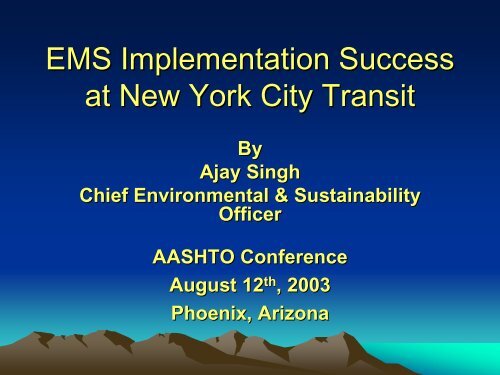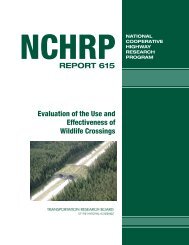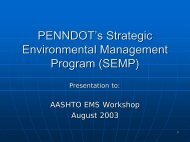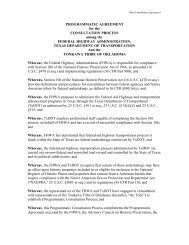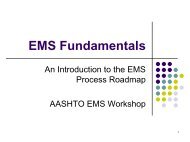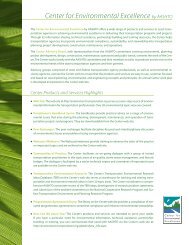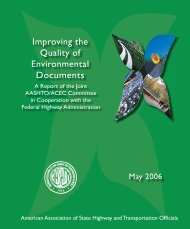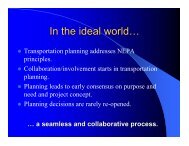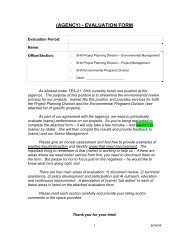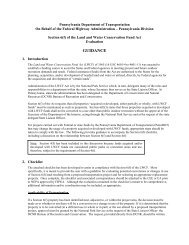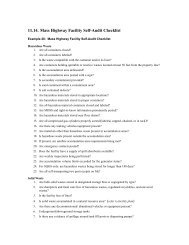EMS Implementation Success at New York City Transit - Center for ...
EMS Implementation Success at New York City Transit - Center for ...
EMS Implementation Success at New York City Transit - Center for ...
You also want an ePaper? Increase the reach of your titles
YUMPU automatically turns print PDFs into web optimized ePapers that Google loves.
<strong>EMS</strong> <strong>Implement<strong>at</strong>ion</strong> <strong>Success</strong><br />
<strong>at</strong> <strong>New</strong> <strong>York</strong> <strong>City</strong> <strong>Transit</strong><br />
By<br />
Ajay Singh<br />
Chief Environmental & Sustainability<br />
Officer<br />
AASHTO Conference<br />
August 12 th , 2003<br />
Phoenix, Arizona
Overview of NYC <strong>Transit</strong><br />
Largest Mass <strong>Transit</strong> System in the US<br />
Approx 50,000 employees<br />
Move 7.2 million passengers daily<br />
4200 buses<br />
6204 trains cars<br />
Approx. 814 miles of track<br />
20 Train maintenance facilities<br />
20 Bus Maintenance facilities<br />
468 Train St<strong>at</strong>ions<br />
24/7
Major Departments of<br />
<strong>New</strong> <strong>York</strong> <strong>City</strong> <strong>Transit</strong><br />
DEPOTS<br />
Buses<br />
MAINTENANCE<br />
FACILITIES<br />
PAINT SHOPS<br />
Capital<br />
Program<br />
Management<br />
DESIGN<br />
&<br />
CONSTRUCTION<br />
Subways<br />
YARDS<br />
MAINTENANCE<br />
FACILITIES<br />
OVERHAUL SHOPS<br />
TRACKS<br />
STATIONS<br />
SIGNALS & LIGHTING<br />
STRUCTURES &<br />
BRIDGES
Capital Program Management<br />
(CPM) Overview<br />
• Service Department<br />
• Design and Construction Management<br />
Department th<strong>at</strong> manages and maintains<br />
the infrastructure th<strong>at</strong> supports the mass<br />
transit system<br />
• Manages 2.1 Billion dollars in capital<br />
projects annually<br />
• 1600 employees, mainly engineers and<br />
architects
Challenge – For CPM to Bring the<br />
System to a St<strong>at</strong>e of Good Repair<br />
Circa 1970<br />
• Accomplish while recognizing and<br />
acknowledging the importance of<br />
environmental protection and preserv<strong>at</strong>ion<br />
• Uphold and exemplify sustained ecological,<br />
economic and social value
Cypress Hill St<strong>at</strong>ion Circa 2000
Inheriting Historic Problems<br />
• Future challenges married to previous practices<br />
• Practices of yesteryears no longer acceptable<br />
Examples:<br />
• Leaking Underground Storage Tanks<br />
• Spills<br />
• High energy consumptions<br />
• Air emissions (VOC from painting)<br />
• Hazardous waste gener<strong>at</strong>ion<br />
• Environmental risk (lead, asbestos)<br />
• Construction site environmental impact (dust, noise,<br />
emissions).
Need to Improve Environmental<br />
Management<br />
• Neg<strong>at</strong>ive public media coverage concerning<br />
environment compliance<br />
• Reoccurring environmental mismanagement<br />
• Associ<strong>at</strong>ed environmental liability<br />
• Increasing cost of oper<strong>at</strong>ions<br />
– Millions in hazardous waste ab<strong>at</strong>ement and disposal<br />
annually<br />
– Insurance<br />
–Health
Choosing Between Solutions<br />
• Meet minimum legal<br />
requirements and<br />
s<strong>at</strong>isfy public<br />
demands<br />
• Surpass minimum<br />
legal requirements<br />
and exceed public’s<br />
expect<strong>at</strong>ion
Choosing Between Solutions<br />
• Raise the bar on<br />
environmental<br />
management<br />
• Obtain management<br />
resolve<br />
• Pursue ISO14001<br />
Environmental<br />
Management
Business R<strong>at</strong>ionale <strong>for</strong> ISO 14001<br />
• Keeping abreast with<br />
industry challenges<br />
• Effective “environmental<br />
accountability”<br />
• Need to reduce<br />
environmental risk<br />
• Need to reduce cost<br />
• Need to reduce liability
Social R<strong>at</strong>ionale <strong>for</strong> ISO 14001<br />
• Willingness to improve<br />
environmental per<strong>for</strong>mance<br />
• Need to assure better rel<strong>at</strong>ions<br />
with the public and community<br />
within which we oper<strong>at</strong>e<br />
• Willingness to instill “change”<br />
• Need to establish a legacy of<br />
environmental excellence
Budget<br />
Schedule Quality Safety Customer S<strong>at</strong>isfaction<br />
Establishing A Corpor<strong>at</strong>e Pillar Of<br />
Environmental Excellence<br />
The pillar of Environmental Excellence is seen as an<br />
integral part of our business <strong>for</strong> the rebuilding and<br />
improvement of the NYC <strong>Transit</strong> system
NYC <strong>Transit</strong> <strong>EMS</strong> Story<br />
• Develop Environmental Policy<br />
• Identifying aspects and impacts<br />
• Set Objectives and Targets<br />
• Implement <strong>EMS</strong><br />
• Achieve ISO14001 Certific<strong>at</strong>ion
March 1999 ISO 14001<br />
Certific<strong>at</strong>ion<br />
• 1 st public sector entity in the United St<strong>at</strong>es<br />
• Part of a US EPA pilot to ascertain benefits of<br />
<strong>EMS</strong> <strong>Implement<strong>at</strong>ion</strong>
Identifying Environmental Aspects<br />
Root of most environmental concerns were<br />
identifiably linked to several key areas:<br />
• Facility & Infrastructure Design and<br />
Construction<br />
• Associ<strong>at</strong>ed process oper<strong>at</strong>ions and<br />
maintenance<br />
• Maintaining the existing 100 year old mass<br />
transit infrastructure (hazard ab<strong>at</strong>ement)
Reduction in Environmental<br />
Footprint as a Measure Of Design<br />
For all projects
2000 Objectives &Targets<br />
• Develop protocol <strong>for</strong> High Per<strong>for</strong>mance<br />
Design <strong>for</strong> the Environment (DfE) and<br />
introduce into each discipline by June 30,<br />
2000
Design <strong>for</strong> the Environment<br />
• Birth of “Green” Designs <strong>at</strong> <strong>New</strong> <strong>York</strong> <strong>City</strong><br />
<strong>Transit</strong><br />
• Applying Green Designs to all capital<br />
projects
Environmentally Responsive Designs<br />
• Control point source and non-point source<br />
pollution through better design and<br />
engineering<br />
• Potential <strong>for</strong> Design and Construction to<br />
play a more proactive role in pollution<br />
prevention<br />
– Historically conducted without rigorous longterm<br />
environment planning<br />
– Viewed as the source point <strong>for</strong> factoring out<br />
environmental concerns
•All Capital Project<br />
from Tunnels to<br />
Train Yards<br />
Scope of DfE
DfE ELEMENTS<br />
(NYCT Green Guidelines)<br />
Sustainable<br />
Design<br />
Energy<br />
Efficiency/<br />
Renewable<br />
Energy<br />
Indoor<br />
Environmental<br />
Quality<br />
Conserving<br />
M<strong>at</strong>erial &<br />
Resources<br />
Full<br />
Commissioning<br />
W<strong>at</strong>er<br />
Conserv<strong>at</strong>ion &<br />
Site Managem.
Circa 2000
Stillwell Avenue Terminal St<strong>at</strong>ion<br />
Circa 1999<br />
Translucent 145kW Photovoltaic Canopy
Aiming For LEED Silver Certific<strong>at</strong>ion –<br />
Corona Shop Circa 2002<br />
• 30% better than code <strong>for</strong> energy efficiency<br />
• Optimize n<strong>at</strong>ural ventil<strong>at</strong>ion and n<strong>at</strong>ural<br />
day lighting<br />
• Altern<strong>at</strong>ive power sources – PV’s and fuel<br />
cells<br />
• Harnessing rain w<strong>at</strong>er <strong>for</strong> washing trains<br />
• Selection of eco-friendly building m<strong>at</strong>erials<br />
• Waste Management and recycling<br />
• ULSD
Central Bus Maintenance Facility<br />
& Depot Circa 2003<br />
• 30% better than code <strong>for</strong> energy efficiency<br />
• Optimize n<strong>at</strong>ural ventil<strong>at</strong>ion and n<strong>at</strong>ural<br />
day lighting<br />
• Altern<strong>at</strong>ive power sources – PV’s and fuel<br />
cells<br />
• Harnessing rain w<strong>at</strong>er <strong>for</strong> washing trains<br />
• Selection of eco-friendly building m<strong>at</strong>erials
Roosevelt Avenue/74th Street<br />
Circa 2000<br />
Conceptual Design
Roosevelt Avenue/74 th Street<br />
Circa 2003
Roosevelt Avenue/74 th Street<br />
Circa 2003
2nd Avenue Subway<br />
Reducing Cooling Loads<br />
St<strong>at</strong>ion cooling loads are gre<strong>at</strong>ly<br />
reduced by extracting hot air from<br />
st<strong>at</strong>ions
2nd Avenue Subway<br />
Increased N<strong>at</strong>ural Lighting &<br />
Energy Efficiency<br />
St<strong>at</strong>ion Lighting is designed around a<br />
power consumption which requires<br />
20% improvement over current code.
All Projects - M<strong>at</strong>erial Selection<br />
• Concrete Composition: R&D to <strong>for</strong>mul<strong>at</strong>e<br />
“green” concrete possibly using fly-ash,<br />
blast furnace slag and SAS spoils<br />
• High Recycled Content: M<strong>at</strong>erials with<br />
high-recycled content, such as structural<br />
steel with and aluminum will be specified
Using Life Cycle Analysis And<br />
Costing<br />
GREEN DECISION MODEL
Cost-Benefit analysis Decision<br />
Model<br />
Energy Efficiency<br />
Increased<br />
First Cost<br />
Payback<br />
Period<br />
Health<br />
Benefit<br />
Productivity<br />
Benefit<br />
Future Cost<br />
Avoidance<br />
Use DOE-2 or similar computer<br />
models as an important interactive<br />
design tool.<br />
Provide integr<strong>at</strong>ed Photovoltaic (PV)<br />
panels <strong>for</strong> both roof and façade<br />
surfaces.<br />
0-1<br />
Cost-Benefit analysis Decision<br />
Models<br />
INDOOR ENVIRONMENTAL QUALITY<br />
CONSERVATION OF MATERIALS<br />
WATER AND SITE MANAGEMENT<br />
OPERATIONS AND MAINTANCE
2001 Objectives &Targets<br />
• Incorpor<strong>at</strong>e Waste<br />
Management<br />
Guidelines in<br />
selected projects
Demolition Waste Recycling<br />
At Roosevelt 86% recycled<br />
–concrete 1869 Metric tons<br />
–steel 112 Metric tons<br />
–wood 17 Metric tons<br />
–landfill 313 Metric tons
Demolition Waste Recycling<br />
At Stillwell 85% recycled<br />
-Concrete 4554 Metric tons<br />
-Steel 351 Metric tons<br />
-Debris 859 Metric tons
Beneficial Reuse of Spoils<br />
• 2001 O&T of Waste<br />
Management was key<br />
to inspiring the<br />
beneficial use of spoils<br />
from major tunneling<br />
projects in Manh<strong>at</strong>tan
Beneficial Reuse of Spoils<br />
2nd Ave Subway<br />
6,100,000<br />
cubic yards<br />
No. 7 Extension (2 Tunnels)<br />
No. 7 Extension (34th and 41st St.<br />
St<strong>at</strong>ion)<br />
391,400<br />
491,400<br />
0 1,000,000 2,000,000 3,000,000 4,000,000 5,000,000 6,000,000 7,000,000<br />
No. 7 Extension (34th and 41st<br />
St. St<strong>at</strong>ion)<br />
No. 7 Extension (2 Tunnels)<br />
2nd Ave Subway<br />
swelled rock volume (cubic yards) 491,400 391,400 6,100,000
<strong>EMS</strong> and Waste Management<br />
• Sets higher standards <strong>for</strong> spoils<br />
management and air quality<br />
• 35 000 (20 cu. Yards) trucks trips required<br />
through out project<br />
• Clean fuel burning truck fleet<br />
• ULSD with diesel oxid<strong>at</strong>ion c<strong>at</strong>alyst<br />
• CNG
2001 Objectives &Targets<br />
• Cre<strong>at</strong>e<br />
Eco-purchasing/<br />
greening of supply<br />
chain awareness<br />
The Best Choice is Not Always Obvious<br />
$ $ Disposal<br />
& Post-<br />
Disposal<br />
Acquisition<br />
Use<br />
Acquisition<br />
Product A<br />
Product B<br />
Product A<br />
Product B<br />
If only acquisition costs are<br />
considered, Product A seems like<br />
the better choice.<br />
In the long run, Product B is<br />
more cost-effective.
Eco-Procurement<br />
The Best Choice is Not Always Obvious<br />
$ $ Disposal<br />
& Post-<br />
Disposal<br />
Use<br />
Acquisition<br />
Acquisition<br />
Product A<br />
Product B<br />
Product A<br />
Product B<br />
If only acquisition costs are<br />
considered, Product A seems like<br />
the better choice.<br />
In the long run, Product B is<br />
more cost-effective.
Pollution Prevention through<br />
Eco-Procurement<br />
• NYC <strong>Transit</strong>’s Green Construction Product<br />
D<strong>at</strong>abase<br />
• Buying Energy Star & Energy Efficient<br />
• Procuring Altern<strong>at</strong>ive Fuel Vehicles<br />
• EPA’s Comprehensive Procurement<br />
Guidelines
Altern<strong>at</strong>ive Fuel Vehicles<br />
Procurement
2002 Objectives &Targets<br />
• Cre<strong>at</strong>e awareness <strong>for</strong> St<strong>at</strong>e Executive<br />
Order on Energy efficiency/conserv<strong>at</strong>ion<br />
EO111
Executive Order 111<br />
• <strong>EMS</strong> enabled prepar<strong>at</strong>ion <strong>for</strong><br />
implementing a 2001 St<strong>at</strong>e Executive<br />
Order on the environment<br />
• Assumed a leadership role st<strong>at</strong>e-wide with<br />
our 3 year head start<br />
• Stand out as a lead and very proactive<br />
agency when it comes to green buildings,<br />
eco-procurement & conserv<strong>at</strong>ion
ISO 14001 <strong>EMS</strong> and Government<br />
Mand<strong>at</strong>es<br />
Voluntary<br />
Mar 98<br />
Environmental<br />
Excellence<br />
Mand<strong>at</strong>ed<br />
Jun 01<br />
ISO 14001<br />
<strong>EMS</strong><br />
Governor’s<br />
Executive Order<br />
Common<br />
Common<br />
Sustainable<br />
Design<br />
Ecoprocurement<br />
Conserv<strong>at</strong>ion
Energy Conserv<strong>at</strong>ion Str<strong>at</strong>egies<br />
• Exploring <strong>New</strong> Energy Saving Technologies<br />
• Remote Energy Monitoring<br />
• Flywheel testing<br />
• Thyristor Rectifier testing<br />
• Humped tracks<br />
• Aluminium contact rails<br />
• Energy Savers<br />
• Facility audits
Energy conserv<strong>at</strong>ion through better designs
Flywheel Energy System<br />
Stores excess 3rd rail voltage<br />
<strong>for</strong> l<strong>at</strong>er use
W<strong>at</strong>er Conserv<strong>at</strong>ion Str<strong>at</strong>egies<br />
•W<strong>at</strong>er Conserv<strong>at</strong>ion and Reclam<strong>at</strong>ion<br />
•Rain W<strong>at</strong>er Harnessing
2003 Objectives &Targets<br />
• Implement Construction <strong>for</strong> Environment<br />
(CfE) during the construction phase <strong>for</strong><br />
projects <strong>for</strong> the 2000-2004 Capital<br />
Program
CfE - Reducing Community Impact
Improving Air Quality – reducing<br />
diesel exhaust pollution<br />
Diesel<br />
oxid<strong>at</strong>ion<br />
c<strong>at</strong>alyst
Improving Air Quality<br />
reduction<br />
Current<br />
20%<br />
50%<br />
Particul<strong>at</strong>e M<strong>at</strong>ter<br />
50%<br />
Hydrocarbons &<br />
Carbon Monoxide<br />
90%<br />
2200 gallons 15 ppm diesel used on non-road<br />
vehicles <strong>at</strong> pilot construction site
2003 Objectives &Targets<br />
• Monitor Design <strong>for</strong> Environment solutions<br />
<strong>for</strong> the planned System Expansion and<br />
Lower Manh<strong>at</strong>tan <strong>Transit</strong> Projects
DfE Decision Model<br />
Start and Finish D<strong>at</strong>es<br />
Idea<br />
Hyperlinked reference.<br />
R<strong>at</strong>ing<br />
Progress<br />
Comments<br />
Detailed Reference
2003 Objectives &Targets<br />
• Obtain Corpor<strong>at</strong>e Acceptance of<br />
Sustainability
Sustainable Development – a Major<br />
Milestone <strong>for</strong> NYCT<br />
• <strong>EMS</strong> paved the way <strong>for</strong> sound<br />
environmental management <strong>at</strong> NYCT<br />
• Senior management’s resolve to further<br />
environmental commitment<br />
• Extension to sustainable development<br />
• Corpor<strong>at</strong>e reporting on social, economic<br />
and environmental indic<strong>at</strong>ors
Advantages of having an<br />
Environmental Management System<br />
• <strong>EMS</strong> is all voluntary supporting and<br />
supplementing environmental compliance<br />
• Stimul<strong>at</strong>es continual improvements<br />
• Continual Improvement af<strong>for</strong>ds pollution<br />
prevention
Advantages of having an<br />
Environmental Management System<br />
• Pollution prevention sustains proactive<br />
environmental management<br />
• Proactive environmental management<br />
drives cost avoidance<br />
• Cost Avoidance maintains economic<br />
competitiveness
Advantages of having an<br />
Environmental Management System<br />
• You don’t get ISO14001 simply to comply<br />
with regul<strong>at</strong>ory requirements<br />
• ISO 14001 is responsible <strong>for</strong> inspiring<br />
innov<strong>at</strong>ive areas of environmental<br />
management within NYCT<br />
– Green Buildings<br />
– Eco-Procurement<br />
– Conserv<strong>at</strong>ion of energy and n<strong>at</strong>ural resources
Cre<strong>at</strong>ing a legacy of<br />
Environmental Excellence<br />
• Always room <strong>for</strong> continual improvements<br />
– Forward moving development of O&T<br />
– Broadening scope of undertaking<br />
– Learning while improving<br />
– Evolving environmentally, economically<br />
and socially
Summary of why <strong>EMS</strong> is important<br />
<strong>for</strong> the Organiz<strong>at</strong>ion<br />
• Assists in meeting corpor<strong>at</strong>e objectives without<br />
impacting the environment<br />
• Commits organiz<strong>at</strong>ion environmentally to reduce<br />
risk<br />
• Sets short and long term goals and objectives<br />
• Assures continual improvements parallel to<br />
management and administr<strong>at</strong>ive realignment<br />
• Assist in <strong>at</strong>taining economic advantage<br />
• Supports global commitment to sustainable<br />
development
<strong>EMS</strong> influences Beneficial Change<br />
Upper Management<br />
Consultants<br />
Designers<br />
Contractors<br />
Vendors<br />
Manufacturers<br />
<strong>EMS</strong><br />
Sister<br />
Engineers<br />
Users<br />
Foreign<br />
agencies<br />
agencies
2004 Objectives &Targets<br />
(Proposed)<br />
• Green all 2005 – 2009 capital plan<br />
projects (Lower Manh<strong>at</strong>tan projects)<br />
• Monitor all projects in construction phase<br />
• Expand the scope of energy conserv<strong>at</strong>ion<br />
to include all process type facilities<br />
• Explore the feasibility of new ab<strong>at</strong>ement<br />
and remedi<strong>at</strong>ion technologies
Shaping The Future - Green<br />
•<strong>Transit</strong> Hub<br />
•<strong>New</strong> South Ferry Terminal<br />
•2nd Avenue Subway<br />
•# 7 Extension<br />
<strong>Transit</strong> Hub<br />
Proposed <strong>New</strong><br />
South Ferry<br />
Terminal
Reducing Environmental Footprint
<strong>New</strong> <strong>York</strong> <strong>City</strong> <strong>Transit</strong><br />
Today from Yesterday<br />
• A significant difference<br />
• Moving towards a cost effective, socially<br />
responsible and environmentally<br />
sustainable future
Cypress Hill St<strong>at</strong>ion Circa 2000
Roosevelt Avenue/74 Street<br />
Circa 2004
OUR GLOBAL COMMITMENT<br />
Sustainable Mass <strong>Transit</strong>


